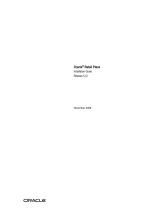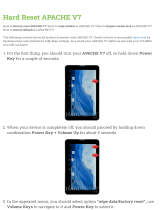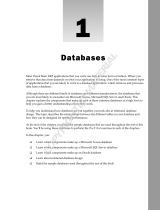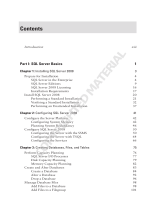Page is loading ...

Oracle9i
Installation Guide
Release 2 (9.2.0.2) for hp OpenVMS Alpha
Part No. B10508-01
December 2002

Oracle9i Installation Guide, Release 2 (9.2.0.2) for hp OpenVMS Alpha
Part No. B10508-01
Copyright © 2002 Oracle Corporation. All rights reserved.
Primary Author: Platform Technologies Division
Contributors: John Dewitt, Grant Hayden, Steve Holck, Pierre Krabbendam, Kevin O’Rourke, Sam
Ravindhran, David Robles, Regina Rohr, Kannan Vishwanathan
The Programs (which include both the software and documentation) contain proprietary information of
Oracle Corporation; they are provided under a license agreement containing restrictions on use and
disclosure and are also protected by copyright, patent and other intellectual and industrial property
laws. Reverse engineering, disassembly or decompilation of the Programs, except to the extent required
to obtain interoperability with other independently created software or as specified by law, is prohibited.
The information contained in this document is subject to change without notice. If you find any
problems in the documentation, please report them to us in writing. Oracle Corporation does not
warrant that this document is error-free. Except as may be expressly permitted in your license
agreement for these Programs, no part of these Programs may be reproduced or transmitted in any form
or by any means, electronic or mechanical, for any purpose, without the express written permission of
Oracle Corporation.
If the Programs are delivered to the U.S. Government or anyone licensing or using the programs on
behalf of the U.S. Government, the following notice is applicable:
Restricted Rights Notice Programs delivered subject to the DOD FAR Supplement are "commercial
computer software" and use, duplication, and disclosure of the Programs, including documentation,
shall be subject to the licensing restrictions set forth in the applicable Oracle license agreement.
Otherwise, Programs delivered subject to the Federal Acquisition Regulations are "restricted computer
software" and use, duplication, and disclosure of the Programs shall be subject to the restrictions in
FAR 52.227-19, Commercial Computer Software - Restricted Rights (June, 1987). Oracle Corporation,
500 Oracle Parkway, Redwood City, CA 94065.
The Programs are not intended for use in any nuclear, aviation, mass transit, medical, or other inherently
dangerous applications. It shall be the licensee's responsibility to take all appropriate fail-safe, backup,
redundancy, and other measures to ensure the safe use of such applications if the Programs are used for
such purposes, and Oracle Corporation disclaims liability for any damages caused by such use of the
Programs.
Oracle is a registered trademark, and PL/SQL, Pro*C, Pro*C/C++, Pro*COBOL, Pro*FORTRAN,
Oracle7, Oracle8, Oracle8i, Oracle9i, Oracle Transparent Gateway, and SQL*Plus are trademarks or
registered trademarks of Oracle Corporation. Other names may be trademarks of their respective
owners.

iii
Contents
Send Us Your Comments ................................................................................................................... ix
Preface............................................................................................................................................................ xi
1 Oracle9i Installation Planning
Oracle9i Installation Overview........................................................................................................ 1-2
Oracle9i Products for Installation .............................................................................................. 1-2
Oracle9i Database Configurations .................................................................................................. 1-4
Environment Descriptions .......................................................................................................... 1-4
Database Configuration Assistant.............................................................................................. 1-5
Installation With Existing Oracle Databases................................................................................. 1-7
System Installation Requirements ................................................................................................. 1-8
Time Requirements ...................................................................................................................... 1-8
Hardware Requirements ............................................................................................................. 1-8
Minimum Hardware Requirements .......................................................................................... 1-8
Disk Space Requirements............................................................................................................ 1-9
Images .......................................................................................................................................... 1-10
Operating System Software Requirements............................................................................. 1-11
Product Dependencies ..................................................................................................................... 1-13
Important Compatibility Issues................................................................................................ 1-13
Additional Product-Specific Installation Requirements....................................................... 1-13
Configuration Restrictions.............................................................................................................. 1-15
Copying Oracle Executables ..................................................................................................... 1-16
Oracle Net Linking Options ........................................................................................................... 1-16

iv
Silent Mode Installation.................................................................................................................. 1-16
What Is a Silent Installation?..................................................................................................... 1-16
What Is a Response File?............................................................................................................ 1-18
Why Perform a Silent Installation? .......................................................................................... 1-18
Modifying a Response File ........................................................................................................ 1-18
Invoking the Installer. ................................................................................................................ 1-19
2 Release Information
Product Set ........................................................................................................................................... 2-2
Changes and Enhancements ............................................................................................................. 2-2
Initialization Parameters in Oracle9i Release 2 That Have Been Desupported.................. 2-5
Initialization Parameters in Oracle9i Release 2 That Are Becoming Obsolete .................... 2-5
Known Restrictions ............................................................................................................................ 2-6
The following items are not supported: .................................................................................... 2-6
3 CD-ROM Pre-installation Requirements
HP OpenVMS and Installation-Specific Issues and Restrictions ............................................ 3-2
New ORA_ROOT ......................................................................................................................... 3-2
Java Runtime Environment (JRE)............................................................................................... 3-2
Character Mode............................................................................................................................. 3-2
Upgrading and Migrating ........................................................................................................... 3-3
File Systems ................................................................................................................................... 3-3
Optimal Flexible Architecture .................................................................................................... 3-3
Using Hummingbird Exceed ...................................................................................................... 3-3

v
Installation Procedure Requirements............................................................................................. 3-4
Oracle Server Database Administrator Account...................................................................... 3-5
Oracle9i Account is NOT the SYS or SYSTEM Account......................................................... 3-6
Oracle9i Account UIC Must Be Greater than MAXSYSGROUP............................................ 3-6
Finding MAXSYSGROUP ........................................................................................................... 3-6
Adding a Record in the User Authorization File (UAF)......................................................... 3-6
Setting Account Privileges .......................................................................................................... 3-8
Setting Account Quotas ............................................................................................................... 3-9
Process Rights for Database Administrators.......................................................................... 3-10
Process Rights for SGA Protection........................................................................................... 3-11
Process Rights for Intelligent Agent (OEMAGENT)............................................................. 3-12
Security Issues with Multiple Databases ................................................................................ 3-12
Completing Account Setup....................................................................................................... 3-12
Verifying Privileges.................................................................................................................... 3-12
HP OpenVMS Alpha SYSGEN Parameters................................................................................. 3-13
Using the Reserved Memory Registry..................................................................................... 3-13
Using AUTOGEN....................................................................................................................... 3-14
HP OpenVMS Alpha System Configuration .............................................................................. 3-16
Setup Tasks to Perform as the SYSTEM User ............................................................................. 3-16
Create an OpenVMS Account to Own Oracle Software....................................................... 3-17
Create an OpenVMS Account to Own the Apache Server................................................... 3-17
Setup Tasks to Perform as the Oracle User ................................................................................. 3-18
Set Permissions for File Creation.............................................................................................. 3-18
Set Display................................................................................................................................... 3-19
Setup Tasks for Oracle Products .................................................................................................... 3-19
Precompilers and Tools ............................................................................................................. 3-19
Network and System Management Products......................................................................... 3-20
4 Installation
Installation Mount Options.............................................................................................................. 4-2
Installation Option, Installing Oracle9i from the Hard Drive................................................... 4-2

vi
Oracle Universal Installer ................................................................................................................. 4-3
Installing an Oracle9i Database .................................................................................................. 4-3
Installing Oracle9i Client ............................................................................................................. 4-6
Reviewing a Log of an Installation Session............................................................................... 4-8
Installing Real Application Clusters .......................................................................................... 4-9
Completing Installation of Oracle9i Server Enterprise Edition ........................................... 4-11
Non-Interactive Installation and Configuration .................................................................... 4-11
Cleaning Up After a Failed Installation................................................................................... 4-11
5 Post-Installation
Database Configuration Assistant (DBCA) ................................................................................... 5-2
Interactive Mode........................................................................................................................... 5-2
Non-interactive Mode.................................................................................................................. 5-2
Using DBCA Response Files ....................................................................................................... 5-4
User Passwords.................................................................................................................................. 5-12
Configuration Tasks to Perform as the System User ................................................................. 5-12
Configuration Tasks to Perform as the Oracle User................................................................... 5-13
Set Initialization Parameters ..................................................................................................... 5-13
Post-Installation for Oracle Products ........................................................................................... 5-14
Oracle Net .................................................................................................................................... 5-14
Oracle Options ............................................................................................................................ 5-15
Shared Server............................................................................................................................... 5-15
Oracle Precompilers ................................................................................................................... 5-16
Oracle Supported Protocols ...................................................................................................... 5-17
Starter Database Contents............................................................................................................... 5-18
Unlocking and Resetting User Passwords.............................................................................. 5-18
Reviewing User Names and Passwords.................................................................................. 5-19
Identifying Databases................................................................................................................. 5-22
Tablespaces and Data Files........................................................................................................ 5-23
Locating the Initialization Parameter File............................................................................... 5-25
Locating Redo Log Files............................................................................................................. 5-25
Locating Control Files................................................................................................................ 5-26
Using Rollback Segments .......................................................................................................... 5-26
Using the Data Dictionary......................................................................................................... 5-26
Adding or Upgrading Products...................................................................................................... 5-27

vii
Relinking the Oracle Code.............................................................................................................. 5-29
Step 1 Shutdown the Given Database(s)................................................................................ 5-29
Step 2 Remove Images .............................................................................................................. 5-29
Step 3 Invoke the Oracle Installation Utility.......................................................................... 5-29
A Oracle9i Products
Oracle9i Database Components ................................................................................................ A-2
Enterprise Edition......................................................................................................................... A-2
SE List............................................................................................................................................. A-5
Oracle9i Client Components ............................................................................................................ A-8
Runtime Edition............................................................................................................................ A-8
Administrator Edition................................................................................................................ A-11
Product Descriptions........................................................................................................................ A-14
B Oracle9i 64-bit Feature
Introduction to the Oracle9i 64-bit Feature.................................................................................... B-2
Introducing the Oracle9i 64-bit Feature .................................................................................... B-2
Benefits of the Oracle9i 64-bit Feature....................................................................................... B-2
Implementation of the Oracle 64-bit Feature on HP OpenVMS Alpha................................ B-2
Suggested Parameter Settings .......................................................................................................... B-3
Other Recommendations................................................................................................................... B-4
C Oracle Transparent Gateway
System Requirements for Oracle Transparent Gateway............................................................. C-2
RDB Gateway Requirements ...................................................................................................... C-3
RMS Gateway Requirements...................................................................................................... C-4
Tested Gateway Configurations................................................................................................. C-6
Gateway Installation Worksheets .............................................................................................. C-6
Installing Oracle Transparent Gateway.......................................................................................... C-8
Mounting Transparent Gateway from the CD-ROM.............................................................. C-8
Installation Prompts for Transparent Gateway ....................................................................... C-8
Removing Oracle Transparent Gateway ........................................................................................ C-9

viii
D Apache Server Installation/Configuration
Post-Installation Checklist................................................................................................................ D-2
Run AUTOGEN ............................................................................................................................ D-2
Check Disk Quota......................................................................................................................... D-2
Check for SET TERMINAL/INQUIRE...................................................................................... D-2
Test the Installation ............................................................................................................................ D-3
Browser Test .................................................................................................................................. D-3
TELNET Test ................................................................................................................................. D-3
Troubleshooting............................................................................................................................ D-4
Running the Oracle HTTP Server on OpenVMS ......................................................................... D-4
Starting and Stopping the Server ............................................................................................... D-4
Server Log File............................................................................................................................... D-4
Customizing the Server Environment ....................................................................................... D-8
How to Configure Apache .......................................................................................................... D-8
Modules and Directives............................................................................................................... D-8
Supported and Unsupported Features................................................................................... D-14
File Formats ................................................................................................................................ D-19
File Naming Conventions......................................................................................................... D-20
File Transfer Process and Access Control List....................................................................... D-20
Logical Names............................................................................................................................ D-21
OpenVMS Cluster Considerations.......................................................................................... D-23
Common Gateway Interface (CGI) ......................................................................................... D-24
Security Information ....................................................................................................................... D-27
Process Model............................................................................................................................. D-27
Privileged Images ...................................................................................................................... D-27
Privileges Required to Start and Stop the Server.................................................................. D-28
File Ownership and Protection................................................................................................ D-29
Server Extensions (CGI Scripts)............................................................................................... D-29
suEXEC Not Available for Protecting Script Execution....................................................... D-29
Open Source Licenses ..................................................................................................................... D-29
Apache................................................................................................................................................ D-29
Index

ix
Send Us Your Comments
Oracle9i Installation Guide, Release 2 (9.2.0.2) for hp OpenVMS Alpha
Part No. B10508-01
Oracle Corporation welcomes your comments and suggestions on the quality and usefulness of this
publication. Your input is an important part of the information used for revision.
■ Did you find any errors?
■ Is the information clearly presented?
■ Do you need more information? If so, where?
■ Are the examples correct? Do you need more examples?
■ What features did you like most about this manual?
If you find any errors or have any other suggestions for improvement, please indicate the chapter,
section, and page number (if available). You can send comments to us at the following e-mail
address:
osdwrite_us@oracle.com
If you would like a reply, please provide your name, address, and telephone number.
If you have problems with the software, please contact your local Oracle Support Services.

x

xi
Preface
Purpose
This guide and the Oracle9i Administrator’s Reference Release 2 (9.2.0.2) for
hp OpenVMS Alpha provide instructions for installing and configuring Oracle9i
Release 2 (9.2.0.2) on hp OpenVMS Alpha systems
. Documentation for the
products that are included with this software is in the Oracle9i generic
documentation set.
Refer to important release information in Chapter 2, "Release Information".
Audience
This document is intended for anyone responsible for installing Oracle9i
Release 2 (9.2.0.2) on OpenVMS Alpha systems.

xii
Documentation Accessibility
Our goal is to make Oracle products, services, and supporting documentation
accessible, with good usability, to the disabled community. To that end, our
documentation includes features that make information available to users of
assistive technology. This documentation is available in HTML format, and
contains markup to facilitate access by the disabled community. Standards will
continue to evolve over time, and Oracle Corporation is actively engaged with other
market-leading technology vendors to address technical obstacles so that our
documentation can be accessible to all of our customers. For additional
information, visit the Oracle Accessibility Program Web site at
http://www.oracle.com/accessibility/
Accessibility of Code Examples in Documentation
JAWS, a Windows screen reader, may not always correctly read the code examples
in this document. The conventions for writing code require that closing braces
should appear on an otherwise empty line; however, JAWS may not always read a
line of text that consists solely of a bracket or brace.
Accessibility of Links to External Web Sites in Documentation
This documentation may contain links to Web sites of other companies or
organizations that Oracle Corporation does not own or control. Oracle Corporation
neither evaluates nor makes any representations regarding the accessibility of these
Web sites.
Oracle9i Standard Edition and Oracle9i Enterprise Edition
Unless noted otherwise, features and functionality described in this document are
common to both Oracle9i Standard Edition and Oracle9i Enterprise Edition.
For the Latest Information
For the latest information about Oracle9i and related products, see the README
files in the Oracle product directories.

xiii
Install Only Licensed Products
You are entitled to install and use only those products for which you have a current
Oracle license agreement.
Typographic Conventions
Command Syntax
HP OpenVMS Alpha command syntax appears in monospace font. The "$"
character at the beginning of command examples should not be entered at the
prompt.
monospace Monospace type indicates OpenVMS DCL commands, directory
names, usernames, pathnames, and filenames.
brackets [ ] Words enclosed in brackets indicate key names (for example,
Press [Return])
. Note that brackets have a different meaning
when used in command syntax.
italics Italic type indicates a logical, including logicals portions of
filenames
. It is also used for emphasis.
UPPERCASE Uppercase letters indicate Structured Query Language (SQL)
reserved words, initialization parameters, and environment
logicals.
hyphen - A hyphen indicates a command that is too long to fit on a single
line
. Enter the line as printed or enter it as a single line without
a hyphen:
copy disk$server25:[oracle920.rdbms.admin]*.sql -
disk$server2:[oracle.rdbms.admin]
braces { } Braces indicate required items: .DEFINE {macro1}
brackets [ ] Brackets indicate optional items: cvtcrt termname [outfile]
Note that brackets have a different meaning when used in
regular text.

xiv
Related Documentation
Information about system administration and tuning for a production database
system is provided in the following documents:
■ Oracle9i Administrator’s Reference Release 2 (9.2.0.2) for hp OpenVMS Alpha
■ Oracle9i Database Administrator’s Guide
■ Oracle9i Net Services Administrator’s Guide
■ Oracle9i Net Services Reference Guide
■ Oracle9i Database Performance Tuning Guide and Reference
Information about migrating from a previous version of Oracle Server is provided
in Oracle9i Database Migration.
ellipses ... Ellipses indicate an arbitrary number of similar items:
CHKVAL fieldname value1 value2... valueN
italics Italic type indicates a variable. Substitute a value for the
logical:
library_name
vertical line | A vertical line indicates a choice within braces or brackets:
SIZE filesize [K|M]

xv
Oracle Services and Support
The Oracle corporate web page is located at the following web site:
http://www.oracle.com
Oracle Corporation offers a wide range of services to help facilitate corporate
system solutions, including Oracle Education courses, Oracle Consulting services,
and Oracle Support Services from the website
. In addition, Oracle Corporation
provides free trial software, updates on Oracle products, and service and technical
brochures and data sheets.
Oracle Support Services
Technical Support contact information worldwide is listed at the following web site:
http://www.oracle.com/support
Templates are provided to help you prepare information about your problem before
you call
. You will also need your CSI number (if applicable) or complete contact
details, including any special project information.
Oracle MetaLink
Oracle MetaLink is the Oracle Corporation web service for technical information.
Members of Oracle MetaLink can search for updates, alerts, patches, and other
information about products, releases, and operating systems, and can set
preferences to be notified automatically of new information
. MetaLink offers a
variety of services to assist in setting up and administering Oracle products,
including procedures, scripts, commentary, and tuning and configuration
best-practices bulletins
. In addition, it offers forums for information sharing
among Oracle customers, and direct communication with Oracle Support
. Oracle
MetaLink is available to Product Support Customers at no extra cost
. Sign up for
free membership for this service at the following web site:
http://www.oracle.com/support/metalink
Use your Support Access Code (SAC) number to register.
Products and Documentation
For U.S.A. customers, Oracle Store is at the following web site:
http://store.oracle.com
Links to Stores in other countries are provided from this site.

xvi
Product documentation can be found at the following web site:
http://docs.oracle.com
Customer Service
Global Customer Service contacts are listed at the following web site:
http://www.oracle.com/support/
Education and Training
Training information and worldwide schedules are available from the following
web site:
http://education.oracle.com
Oracle Technology Network
Register with the Oracle Technology Network (OTN) at the following web site:
http://technet.oracle.com
OTN delivers technical papers, code samples, product documentation, self-service
developer support, and Oracle key developer products to enable rapid
development and deployment of applications built on Oracle technology.
Support for Hearing and Speech Impaired Customers
Oracle Corporation provides dedicated Text Telephone (TTY) access to Oracle
Support Services within the United States of America 24 hours a day, 7 days a week.
■ For technical questions, call:
1.800.446.2398
■ For non-technical questions, call:
1.800.464.2330

Oracle9i Installation Planning 1-1
1
Oracle9i Installation Planning
This chapter describes the Oracle9i installation types and configurations.
The following topics are included:
■ Oracle9i Installation Overview
■ System Installation Requirements
■ Product Dependencies
■ Configuration Restrictions
■ Oracle Net Linking Options

Oracle9i Installation Overview
1-2 Oracle9i Installation Guide Release 2 (9.2.0.2) for HP Alpha OpenVMS
Oracle9i Installation Overview
The installation of Oracle9i products has five stages:
1. Planning your installation: Use this chapter to help you plan and prepare for
your installation
. This chapter provides information about products,
installation types, database configurations, and concepts that you should be
aware of during planning and installation.
2. Completing pre-installation tasks: Refer to the release notes for your
platform, and see Chapter 3, "CD-ROM Pre-installation Requirements" in this
guide to complete pre-installation tasks.
3. Installing software: Use the Oracle Universal Installer that is provided on
your CD-ROM to install Oracle products (requires DECWindows Motif). Refer
to Chapter 4, "Installation".
4. Completing the post-installation tasks: Create database objects, establish the
user environment, and configure the installed Oracle products for the local
system
. Refer to Chapter 5, "Post-Installation".
5. Installing the clients: If you want to install client tools, applications, and
client interfaces that are not included on the Oracle9i CD-ROM, then check the
requirements and instructions in the documentation for those products.
The following sections describe the choices of installation for different systems and
environments.
Oracle9i Products for Installation
During installation, you are asked to choose one of two products. These products
are:
■ Oracle9i Database
■ Oracle9i Client

Oracle9i Installation Overview
Oracle9i Installation Planning 1-3
Oracle9i Database
The Oracle9i Database is an object-oriented relational database management system
that consists of an Oracle database and an Oracle instance
. It may be installed in
one of three installation types: Enterprise Edition, Standard Edition, or Custom
installation.
■ Enterprise Edition: If you select this type, then the Oracle Universal Installer
installs a preconfigured starter database, licensable Oracle options, networking
services, and Oracle utilities
. The Enterprise Edition contains the set of
products that are most commonly used for database environments.
■ Standard Edition: If you select this type, then the Oracle Universal Installer
installs a preconfigured starter database, networking services, and Oracle
utilities.
■ Custom: If you select this type, then the Oracle Universal Installer installs the
products that you select from the Enterprise Edition and from the Standard
Edition options.
Oracle9i Client
The Oracle9i Client is a front-end database application that connects to the database
through one or more application servers
. Three client installation types are
available: Administrator, Runtime, and Custom.
■ Administrator: If you select this type, then the Oracle Universal Installer
installs networking services, utilities, and basic client software.
■ Runtime: If you select this type, then the Oracle Universal Installer installs
networking services and support files.
■ Custom: If you select this type, then the Oracle Universal Installer prompts
you to select individual components to install from the components that are
available with Administrator and Runtime.

Oracle9i Database Configurations
1-4 Oracle9i Installation Guide Release 2 (9.2.0.2) for HP Alpha OpenVMS
Oracle9i Database Configurations
When you install the Oracle9i database product, you are prompted to select a
database configuration that is suited to your needs
. Select from one of five Oracle9i
database configurations:
1. General Purpose
2. Online Transaction Processing
3. Data Warehouse
4. Customized
5. Software Only
Options one through three are preconfigured databases that you can use for your
Oracle9i database
. Each preconfigured database is designed to provide optimal
support for particular database needs
. Options four and five are configurations for
special needs
. The following section describes some of these configurations.
Environment Descriptions
General Purpose
Users of this database type perform a variety of database tasks, ranging from simple
transactions to complex queries
. Select this database environment for general
purpose use.
Online Transaction Processing
Users of this database type perform large numbers of concurrent transactions, in
which each transaction is a relatively simple operation that is processing a small
amount of data
. Transactions consist of reading, writing, and deleting data in
database tables.
Billing databases, such as those commonly found on Internet commerce sites, are
the most common example of this database configuration
. These databases are also
known as Online Transaction Processing (OLTP) databases.
/




